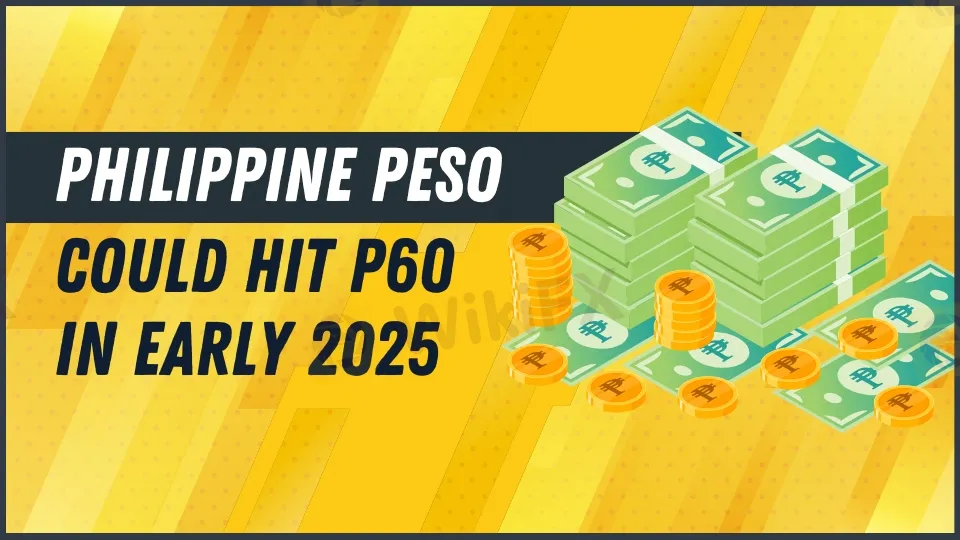简体中文
繁體中文
English
Pусский
日本語
ภาษาไทย
Tiếng Việt
Bahasa Indonesia
Español
हिन्दी
Filippiiniläinen
Français
Deutsch
Português
Türkçe
한국어
العربية
Philippine Peso Could Hit P60 in Early 2025, DBS Says
Sommario:DBS forecasts the Philippine peso to hit P60 per dollar in early 2025, with factors like US monetary policy and Trump’s trade tariffs affecting the outlook.

Philippine Peso Could Hit P60 Per Dollar in 2025, DBS Predicts
According to a recent projection from DBS Bank, the Philippine peso might reach P60 per dollar by the first half of 2025. The banking institution expects the peso to remain at this level from the first to second quarters of 2025, before rising to P58.90 by the third quarter and P57.30 by the end of the year.
The DBS Bank estimate comes amid fears over a higher US currency, which they ascribe to US President-elect Donald Trump's possible economic policies. According to DBS, Trump's second-term strategy might have an impact on currency markets, causing the US dollar to gain and the peso to weaken. Trump's planned tariffs on Chinese goods, as well as a universal tax, are projected to raise inflation, potentially affecting global trade and financial connections.
“Although markets viewed Trump's tariffs as a transactional policy approach to extract leverage in negotiations, not all countries would be willing or able to meet his demands, resulting in retaliatory measures,” says DBS. According to the paper, such trade battles might damage corporate confidence and limit the Federal Reserve's capacity to lower interest rates, contributing to global economic uncertainty.
Furthermore, the peso fell to a record low of P59 per dollar on November 21 and 26, indicating the present instability in the currency market.

Factors Affecting Peso Depreciation
A supplementary analysis from the ASEAN+3 Macroeconomic Research Office (AMRO) identified probable causes that might exacerbate the peso's weakness. The office cautioned that uncertainty about US monetary policy, the global economy, and geopolitical concerns might cause the peso to remain volatile.
AMRO stated that delays in the US Federal Reserve's easing cycle might lead to additional depreciation of the peso. “A slower-than-expected monetary policy easing in the US compared to market expectations could trigger a peso depreciation,” according to the paper. While the Fed's move to lower the federal funds rate in September was noteworthy, it did not give clarity on future rate decreases, which is still a crucial element to monitor for the peso's stability in 2025.
Effects of Peso Depreciation on the Philippine Economy
While a lower peso may assist overseas Filipino workers (OFWs) and exporters by raising the value of their remittances and export earnings, it also poses problems to the greater economy. AMRO said that substantial depreciation might lead to increased import prices, putting importers and producers under pressure. These greater expenses might eventually be passed on to consumers, resulting in inflationary pressure.
According to the research, a protracted depreciation might boost government bond rates, raising the Philippines' borrowing expenses and potentially hurting the country's fiscal health.
Last Thoughts
The Philippine peso's future remains unknown since different global influences influence its fluctuations. The potential impact of US monetary policy changes, as well as trade tensions under Trump's leadership, will be crucial indicators to watch. As the peso becomes more volatile, the Philippines may need to use foreign exchange interventions to reduce excessive fluctuations. The year 2025 will be a watershed moment for the peso, with its performance reflecting wider economic trends in the United States and throughout the world.

Disclaimer:
Le opinioni di questo articolo rappresentano solo le opinioni personali dell’autore e non costituiscono consulenza in materia di investimenti per questa piattaforma. La piattaforma non garantisce l’accuratezza, la completezza e la tempestività delle informazioni relative all’articolo, né è responsabile delle perdite causate dall’uso o dall’affidamento delle informazioni relative all’articolo.
WikiFX Trader
Vantage
FP Markets
VT Markets
GO MARKETS
STARTRADER
Octa
Vantage
FP Markets
VT Markets
GO MARKETS
STARTRADER
Octa
WikiFX Trader
Vantage
FP Markets
VT Markets
GO MARKETS
STARTRADER
Octa
Vantage
FP Markets
VT Markets
GO MARKETS
STARTRADER
Octa
Rate Calc


